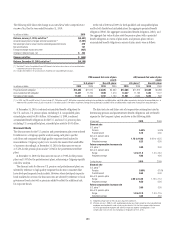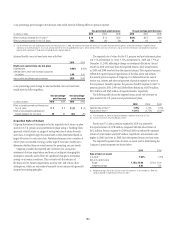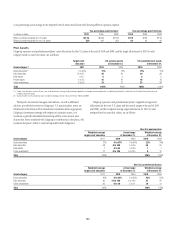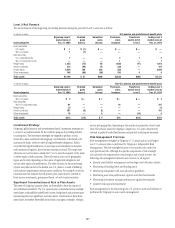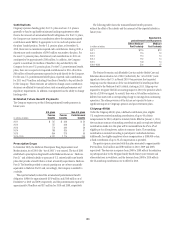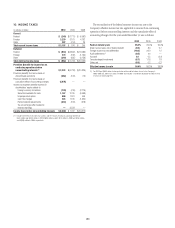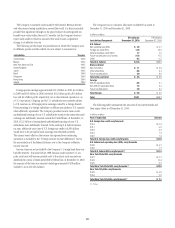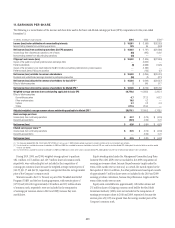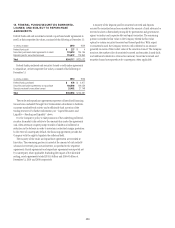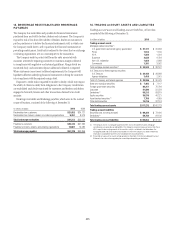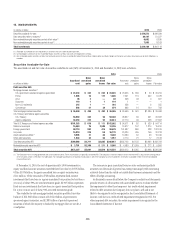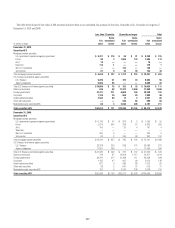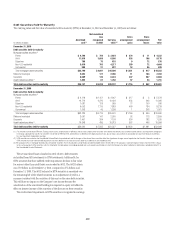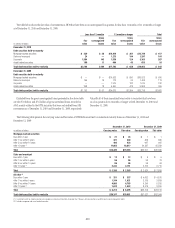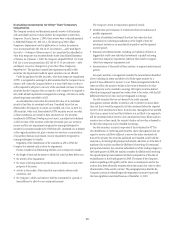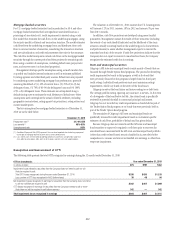Citibank 2010 Annual Report Download - page 204
Download and view the complete annual report
Please find page 204 of the 2010 Citibank annual report below. You can navigate through the pages in the report by either clicking on the pages listed below, or by using the keyword search tool below to find specific information within the annual report.202
With respect to the New York NOLs, the Company has recorded a net
deferred tax asset of $1.1 billion, along with less significant net operating
losses in various other states for which the Company has recorded a net
deferred tax asset of $0.6 billion and which expire between 2012 and
2031. In addition, the Company has recorded deferred tax assets in foreign
subsidiaries, for which an assertion has been made that the earnings
are indefinitely reinvested, for foreign net operating loss carryforwards
of $487 million (which expire in 2012–2019) and $60 million (with no
expiration), respectively.
Although realization is not assured, the Company believes that the
realization of the recognized net deferred tax asset of $52.1 billion is more
likely than not based upon expectations as to future taxable income in the
jurisdictions in which the DTAs arise and available tax planning strategies,
as defined in ASC 740, Income Taxes, (formerly SFAS 109) that would be
implemented, if necessary, to prevent a carryforward from expiring. Included
in the net U.S. federal DTA of $41.6 billion are $4 billion in DTLs that will
reverse in the relevant carryforward period and may be used to support the
DTA, and $0.3 billion in compensation deductions that reduced additional
paid-in capital in January 2011 and for which no adjustment was permitted
to such DTA at December 31, 2010 because the related stock compensation
was not yet deductible to Citi. In general, the Company would need to
generate approximately $105 billion of taxable income during the respective
carryforward periods to fully realize its U.S. federal, state and local DTAs.
As a result of the losses incurred in 2008 and 2009, the Company is
in a three-year cumulative pretax loss position at December 31, 2010. A
cumulative loss position is considered significant negative evidence in
assessing the realizability of a DTA. The Company has concluded that
there is sufficient positive evidence to overcome this negative evidence. The
positive evidence includes two means by which the Company is able to fully
realize its DTA. First, the Company forecasts sufficient taxable income in the
carryforward period, exclusive of tax planning strategies, even under stressed
scenarios. Secondly, the Company has sufficient tax planning strategies,
including potential sales of businesses and assets, in which it could realize
the excess of appreciated value over the tax basis of its assets. The amount
of the DTA considered realizable, however, is necessarily subject to the
Company’s estimates of future taxable income in the jurisdictions in which it
operates during the respective carryforward periods, which is in turn subject
to overall market and global economic conditions.
Based upon the foregoing discussion, as well as tax planning
opportunities and other factors discussed below, the U.S. federal and New
York State and City net operating loss carryforward period of 20 years provides
enough time to utilize the DTAs pertaining to the existing net operating loss
carryforwards and any NOL that would be created by the reversal of the future
net deductions that have not yet been taken on a tax return.
The U.S. foreign tax credit carryforward period is 10 years. In addition,
utilization of foreign tax credits in any year is restricted to 35% of foreign
source taxable income in that year. Further, overall domestic losses that
the Company has incurred of approximately $47 billion are allowed to be
reclassified as foreign source income to the extent of 50% of domestic source
income produced in subsequent years and such resulting foreign source
income is in fact sufficient to cover the foreign tax credits being carried
forward. As such, the foreign source taxable income limitation will not be
an impediment to the foreign tax credit carryforward usage as long as the
Company can generate sufficient domestic taxable income within the 10-year
carryforward period. Under U.S. tax law, NOL carry-forwards must generally
be used against taxable income before foreign tax credits (FTCs) or general
business credits (GBCs) can be utilized.
Regarding the estimate of future taxable income, the Company has
projected its pretax earnings predominantly based upon the “core”
businesses in Citicorp that the Company intends to conduct going forward.
These “core” businesses have produced steady and strong earnings in the
past. In 2010, operating trends were positive and credit costs improved. The
Company has already taken steps to reduce its cost structure. Taking these
items into account, the Company is projecting that it will generate sufficient
pretax earnings within the 10-year carryforward period alluded to above
to be able to fully utilize the foreign tax credit carryforward, in addition to
any foreign tax credits produced in such period. Until the U.S. federal NOL
carryforward is fully utilized, the FTCs and GBCs will likely continue to
increase. The Company’s net DTA will decline as additional domestic GAAP
taxable income is generated.
The Company has also examined tax planning strategies available to
it in accordance with ASC 740 that would be employed, if necessary, to
prevent a carryforward from expiring. These strategies include repatriating
low-taxed foreign source earnings for which an assertion that the earnings
are indefinitely reinvested has not been made, accelerating U.S. taxable
income into or deferring U.S. tax deductions out of the latter years of the
carryforward period (e.g., selling appreciated intangible assets and electing
straight-line depreciation), accelerating deductible temporary differences
outside the U.S., holding onto available-for-sale debt securities with losses
until they mature and selling certain assets that produce tax exempt income,
while purchasing assets that produce fully taxable income. In addition,
the sale or restructuring of certain businesses can produce significant U.S.
taxable income within the relevant carryforward periods.
The Company’s ability to utilize its DTAs to offset future taxable income
may be significantly limited if the Company experiences an “ownership
change,” as defined in Section 382 of the Internal Revenue Code of 1986, as
amended (the “Code”). In general, an ownership change will occur if there
is a cumulative change in the Company’s ownership by “5% shareholders”
(as defined in the Code) that exceeds 50 percentage points over a rolling
three-year period. A corporation that experiences an ownership change will
generally be subject to an annual limitation on its pre-ownership change
DTAs equal to the value of the corporation immediately before the ownership
change, multiplied by the long-term tax-exempt rate (subject to certain
adjustments), provided that the annual limitation would be increased
each year to the extent that there is an unused limitation in a prior year.
The limitation arising from an ownership change under Section 382 on
Citigroup’s ability to utilize its DTAs will depend on the value of Citigroup’s
stock at the time of the ownership change. Under IRS Notice 2010-2,
Citigroup did not experience an ownership change within the meaning
of Section 382 as a result of the sales of its common stock held by the
U.S. Treasury.



